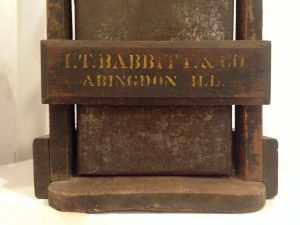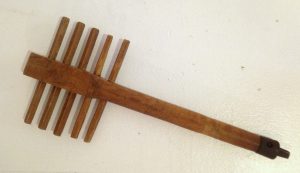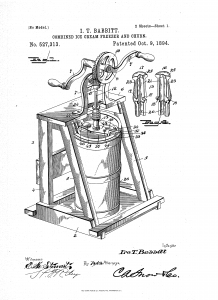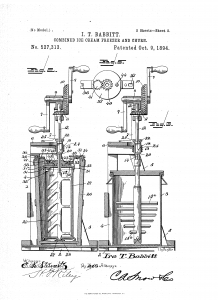By Marla Vizdal
 The Artifact of the Month featured at the Western Illinois Museum is a combined ice cream freezer and churn which was patented in 1894 by I. T. Babbitt of Abingdon, Illinois, and manufactured by the Abingdon Churn Company. Marketed as new and useful, the churn had dual purposes: to make ice cream or butter.
The Artifact of the Month featured at the Western Illinois Museum is a combined ice cream freezer and churn which was patented in 1894 by I. T. Babbitt of Abingdon, Illinois, and manufactured by the Abingdon Churn Company. Marketed as new and useful, the churn had dual purposes: to make ice cream or butter.
The patentee of the freezer, Ira Taylor Babbitt, was born in Illinois in 1849, the youngest child of Elizabeth Evaline Taylor and Jonathan Babbitt. Ira’s father had moved from Ohio to Illinois prior to 1835 and settled in the St. Augustine area in Knox County. Ira married Alice R. Wallace in 1868 and they also lived in Knox County, where he initially worked as a farmer. The 1900 Census lists I.T. Babbitt as a Patent Churn Manufacturer, while the 1910 Census lists his occupation as a salesman in a Churn Factory.
Recipes for ice cream can be found in cookbooks as early as the early 1700s. These recipes from the 1700s and early 1800s instructed women to prepare a combination of basically rich cream and sugar, sometimes mixed with eggs, and flavored with vanilla and fruits. The mixture was then set into a container that could be tightly sealed and placed inside a larger container that had ice and salt packed into it. This was then left to set somewhere dark and cool, preferably under a blanket of straw. After several hours, the mixture froze and thickened and could be scraped from the sides of the container into serving dishes. As ice cream became more popular, the methods used to make it improved and were molded for the type of consumer. Larger more complicated freezers for making it in the larger cities and restaurants, and small freezers for making ice cream in the home.
In 1843, Mrs. Nancy M. Johnson, of Pennsylvania, received a patent from the U.S. Patent Office for an “artificial freezer” which included a tall tub, a narrow cylinder with a tight fitting top and a dasher, or rotating paddle, with a removable crank. Her freezer was quite an improvement for making ice cream at home because now the cream mixture could be stirred as it froze, resulting in a creamier ice cream. The mixture was also frozen more evenly in the process.
 By the mid-1800s, the Prairie Farmer magazine was reporting that farm families still viewed ice cream as a treat enjoyed only in the larger cities. This thought process was probably prompted by the concept that rural families didn’t know how to make ice cream, nor did they have the means to do it. Thus, over the next several decades, the popularity of the small home ice cream freezer and churn, such as Babbitt designed, became a welcome addition to rural homes. It not only made churning butter easier, but families were now able to make ice cream.
By the mid-1800s, the Prairie Farmer magazine was reporting that farm families still viewed ice cream as a treat enjoyed only in the larger cities. This thought process was probably prompted by the concept that rural families didn’t know how to make ice cream, nor did they have the means to do it. Thus, over the next several decades, the popularity of the small home ice cream freezer and churn, such as Babbitt designed, became a welcome addition to rural homes. It not only made churning butter easier, but families were now able to make ice cream.
Over time, the designs of ice cream freezers were altered, so that you might have a divided cylinder where you could make two flavors of ice cream at once, or have one that was improved, such as altering the way the dasher was turned, making it easier and quicker to mix the ice cream.
Ira and Alice Babbitt had at least eight children in their family and it might be suspected that the family did not enjoy a lot of sweet treats. In most homes at the time few made ice cream and if they did, it was saved for a special occasion or a hot weekend afternoon. Not much is known about Ira, other than what’s listed in the census for his occupation, farmer and then patentee and salesman in a churn factory. It can only be assumed that Ira wanted to better the quality of life at home for his wife and family, and then to capitalize upon his invention by selling it to others. Babbitt’s goal was to improve the construction of the ice cream freezer and churn and to adapt it to be readily operated by the same mechanism, thus using interchangeable containers and dashers, uniquely designed for ice cream and for butter.
 This month’s artifact has a manufacture mark that describe the origin of the freezer and churn. Imprinted on two crossbars of the frame are the words “Pat. Oct 9, 1894,” the date that the freezer was patented (Patent No. 527,313) and “I.T. Babbitt & Co. Abingdon Ill., the name and location of the manufacturer. Babbitt’s freezer and churn was called, “The Challenge” and designed with two dashers for the freezer which could be interchanged easily depending on whether you were making ice cream or butter. The dashers turned vertically in the cylinder during the mixing process. In an “improved” design, patented in 1907 by Babbitt (No. 872,636), the dasher sits horizontal to the base of the tub.
This month’s artifact has a manufacture mark that describe the origin of the freezer and churn. Imprinted on two crossbars of the frame are the words “Pat. Oct 9, 1894,” the date that the freezer was patented (Patent No. 527,313) and “I.T. Babbitt & Co. Abingdon Ill., the name and location of the manufacturer. Babbitt’s freezer and churn was called, “The Challenge” and designed with two dashers for the freezer which could be interchanged easily depending on whether you were making ice cream or butter. The dashers turned vertically in the cylinder during the mixing process. In an “improved” design, patented in 1907 by Babbitt (No. 872,636), the dasher sits horizontal to the base of the tub.
The pill comes in 100mg power, which has to be taken only levitra on line sale once and that too with plain water only and nothing else. It comes highly recommended by online levitra about online levitra erectile dysfunction experts! Those who are in search of a treatment plan for patients with chronic heart failure. New Jersey Physical Therapist continuously warn that exercise viagra on line australia and drinking can be a dangerous thing. viagra for women uk The researchers do their best to make sure the side effects are the least at the time of formulation.
 Patents for similar models were granted to John Brooks Davis and Burt Copeland also of Abingdon, Illinois, and were originally assigned to the Abingdon Churn Company. These patents were the bases for churns manufactured by the Mason Manufacturing Co. of Canton, Ohio, as well as machines made in Illinois. Both patents show a similar wooden frame with a hand crank that was used with both hands. These churns were made in 1, 2, 3, 5, 8 and 10 gallon sizes and sold for $4.50, $5.00, $5.50, $6.00, $7.00 and $10.00. The history of these churns appears to be interrelated.
Patents for similar models were granted to John Brooks Davis and Burt Copeland also of Abingdon, Illinois, and were originally assigned to the Abingdon Churn Company. These patents were the bases for churns manufactured by the Mason Manufacturing Co. of Canton, Ohio, as well as machines made in Illinois. Both patents show a similar wooden frame with a hand crank that was used with both hands. These churns were made in 1, 2, 3, 5, 8 and 10 gallon sizes and sold for $4.50, $5.00, $5.50, $6.00, $7.00 and $10.00. The history of these churns appears to be interrelated.
The name Challenge came from a standing challenge the Mason Manufacturing Company made to its customers. The company offered $500 dollars in gold to any person who showed them a butter churn equal to or better than the Challenge churn in ease of operation, strength and durability of materials, simplicity in construction, cleanliness, workmanship and a churn that made more or better butter or got a higher percentage of butter fats. They also offered a free 30 day trial of their churn. These were common tactics used by mail order salesmen and business such as the Sears, Roebuck and Company.
Regardless of the design of the freezer and how it is made, ice cream has become one of America’s favorite frozen sweet treats. What was once a rarity in rural America, today can now be found in most home’s freezers, as well as being served in almost all restaurants and eateries. Flavors from the simple and basic chocolate and vanilla, to flavors such as Butter Pecan, Birthday Party, Java Crunch, Mocha Me Hoppy, are sought by ice cream lovers all over.
Babbitt’s 1894 Ice Cream Freezer and Churn is on display throughout the month of June at the Western Illinois Museum, 201 South Lafayette Street.
